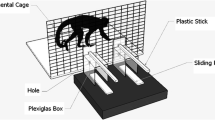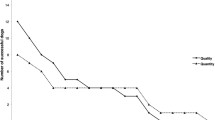Abstract
Animals commonly face choices requiring them to wait and postpone action. The ability to delay gratification is a prerequisite for making future-oriented decisions. We investigated the ability of brown capuchins (Cebus apella) and Tonkean macaques (Macaca tonkeana) to delay benefits in several experiments. In exchange tasks, subjects had to return a piece of cookie after a given time lag to obtain a larger one from an experimenter. Capuchins could wait 10–40 s and macaques 20–80 s depending on subjects and the size of rewards. Both groups were able to anticipate delay durations, but unlike macaques, capuchins discounted all sizes of reward at the same speed, meaning that their delay-maintenance was not affected by the reward size. When the subjects could give the initial piece of cookie back immediately and then wait for the return, performances increased to 10–21 min for capuchins and 21–42 min for macaques, demonstrating the role of consumption inhibition in postponing gratification. In a further task, we presented subjects with an accumulation of food pieces added at short intervals until they seized them. On average, brown capuchins could wait 33–42 s and macaques 38–72 s before seizing the rewards. Our results confirmed that brown capuchins were more impulsive than Tonkean macaques in several tasks. We did not find significant differences between the waiting performances of the Tonkean macaques and those previously reported in long-tailed macaques. The contrasting performances of macaques and capuchins might be related to their different skills in the physical and social domains.





Similar content being viewed by others

References
Abeyesinghe, S. M., Nicol, C. J., Hartnell, S. J., & Wathes, C. M. (2005). Can domestic fowl, Gallus gallus domesticus, show self-control? Animal Behaviour, 70, 1–11.
Addessi, E., Crescimbene, L., & Visalberghi, E. (2007). Do capuchin monkeys (Cebus apella) use tokens as symbols? Proceedings of the Royal Society of London B: Biological Series, 274, 2579–2585.
Addessi, E., Crescimbene, L., & Visalberghi, E. (2008). Food and token quantity discrimination in capuchin monkeys (Cebus apella). Animal Cognition, 11, 275–282.
Amici, F., Aureli, F., & Call, J. (2008). Fission-fusion dynamics, behavioral flexibility and inhibitory control in primates. Current Biology, 18, 1415–1419.
Amici, F., Call, J., & Aureli, F. (2009). Variation in withholding of information in three monkey species. Proceedings of the Royal Society of London B: Biological Series, 276, 3311–3318.
Anderson, J. R. (1996). Chimpanzees and capuchin monkeys: comparative cognition. In A. E. Russon, K. A. Bard, & S. T. Parker (Eds.), Reaching into thought: The minds of the great apes (pp. 23–56). Cambridge: Cambridge University Press.
Aureli, F., Das, M., & Veenema, H. C. (1997). Differential kinship effect on reconciliation in three species of macaques (Macaca fascicularis, M. fuscata, and M. sylvanus). Journal of Comparative Psychology, 111, 91–99.
Beran, M. J. (2002). Maintenance of self-imposed delay of gratification by four chimpanzees (Pan troglodytes) and an orangutan (Pongo pygmaeus). The Journal of General Psychology, 129, 49–66.
Brosnan, S. F., & de Waal, F. B. M. (2004). A concept of value during experimental exchange in brown capuchin monkeys, Cebus apella. Folia Primatologica, 75, 317–330.
Brosnan, S. F., & de Waal, F. B. M. (2005). Responses to a simple barter task in chimpanzees, Pan troglodytes. Primates, 46, 173–182.
Brunner, D., & Gibbon, J. (1995). Value of food aggregates: parallel versus serial discounting. Animal Behaviour, 50, 1627–1634.
Chalmeau, R., & Peignot, P. (1998). Exchange of objects between human and captive western lowland gorillas. Primates, 39, 389–398.
Drapier, M., Chauvin, C., Dufour, V., Uhlrich, P., & Thierry, B. (2005). Food-exchange with humans in brown capuchin monkeys. Primates, 46, 241–248.
Dufour, V., Pelé, M., Sterck, E. H. M., & Thierry, B. (2007). Chimpanzee (Pan troglodytes) anticipation of food return: coping with waiting time in an exchange task. Journal of Comparative Psychology, 121, 145–155.
Evans, T. A., & Beran, M. J. (2007a). Delay of gratification and delay maintenance by rhesus macaques (Macaca mulatta). The Journal of General Psychology, 134, 199–216.
Evans, T. A., & Beran, M. J. (2007b). Chimpanzees use self-distraction to cope with impulsivity. Biology Letters, 3, 599–602.
Fragaszy, D. M., Visalberghi, E., & Fedigan, L. M. (2004). The complete capuchin: the biology of the genus Cebus. Cambridge: Cambridge University Press.
Green, L., & Myerson, J. (1996). Exponential versus hyperbolic discounting of delayed outcomes: Risk and waiting time. American Zoologist, 36, 496–505.
Green, L., Myerson, J., Holt, D. D., Slevin, J. R., & Estle, S. J. (2004). Discounting of delayed food rewards in pigeons and rats: is there a magnitude effect? Journal of the Experimental Analysis of Behavior, 81, 39–50.
Grosch, J., & Neuringer, A. (1981). Self-control in pigeons under the Mischel paradigm. Journal of the Experimental Analysis of Behavior, 35, 3–21.
Haccou, P., & Meelis, E. (1992). Statistical analysis of behavioural data. Oxford: Oxford University Press.
Hyatt, C. W., & Hopkins, W. D. (1998). Interspecies object exchange: bartering in apes? Behavioural Processes, 42, 177–187.
Kacelnik, A. (2003). The evolution of patience. In G. Loewenstein, D. Read, & R. Baumeister (Eds.), Time and decision: Economic and psychological perspectives on intertemporal choice (pp. 115–138). New York: Russell Sage Foundation.
Kagel, J. H., Green, L., & Caraco, T. (1986). When foragers discount the future: constraint or adaptation? Animal Behaviour, 34, 271–283.
Killeen, P. R., Smith, J. P., & Hanson, S. J. (1981). Central place foraging in Rattus norvegicus. Animal Behaviour, 29, 64–70.
Lefebvre, L. (1982). Food exchange strategies in an infant chimpanzee. Journal of Human Evolution, 11, 195–204.
Mazur, J. E. (1987). An adjusting procedure for studying delayed reinforcement: The effects of delay and intervening events on reinforcement value. In M. L. Commons, J. E. Mazur, J. A. Nevin, & H. Rachlin (Eds.), Quantitative analyses of behavior (Vol. 5, pp. 55–73). Hillsdale, NJ: Lawrence Erlbaum.
Mischel, W. (1974). Processes in delay of gratification. In L. Berkowitz (Ed.), Advances in experimental social psychology (pp. 249–292). New York: Academic Press.
Pelé, M., Dufour, V., Micheletta, J., & Thierry, B. (2010). Long-tailed macaques display unexpected waiting abilities in exchange tasks. Animal Cognition, 13, 263–271.
Ramseyer, A., Pelé, M., Dufour, V., Chauvin, C., & Thierry, B. (2006). Accepting loss: the temporal limits of reciprocity in brown capuchin monkeys. Proceedings of the Royal Society of London B: Biological Series, 273, 179–184.
Richards, J. B., Mitchell, S. H., de Wit, H., & Seiden, L. S. (1997). Determination of discount functions in rats with an adjusting-amount procedure. Journal of the Experimental Analysis of Behavior, 67, 353–366.
Rosati, A. G., Stevens, J. R., Hare, B., & Hauser, M. D. (2007). The evolutionary origins of human patience: temporal preferences in chimpanzees, bonobos, and human adults. Current Biology, 17, 1663–1668.
Schino, G., di Giuseppe, F., & Visalberghi, E. (2009). Grooming, rank, and agonistic support in tufted capuchin monkeys. American Journal of Primatology, 71, 101–105.
Siegel, S., & Castellan, N. J. (1988). Nonparametric statistics for the behavioral sciences. Singapore: McGraw-Hill.
Stevens, J. R., Hallinan, E. V., & Hauser, M. D. (2005). The ecology and evolution of patience in two New World monkeys. Biology Letters, 1, 223–226.
Stevens, J. R., Cushman, F. A., & Hauser, M. D. (2005). Evolving the psychological mechanisms for cooperation. Annual Review of Ecology and Systematics, 36, 499–518.
Thierry, B. (1986). A comparative study of aggression and response to aggression in three species of macaque. In J. G. Else & P. C. Lee (Eds.), Primate ontogeny, cognition, and social behaviour (pp. 307–313). Cambridge: Cambridge University Press.
Thierry, B. (2007). Unity in diversity: lessons from macaque societies. Evolutionary Anthropology, 16, 224–238.
Thierry, B., Aureli, F., Nunn, C., Petit, O., Abegg, C., & de Waal, F. B. M. (2008). A comparative study of conflict resolution in macaques: insights into the nature of trait covariation. Animal Behaviour, 75, 847–860.
Toner, I. J., & Smith, R. A. (1977). Age and overt verbalization in delay-maintenance behavior in children. Journal of Experimental Child Psychology, 24, 123–128.
Toner, I. J., Lewis, B. C., & Gribble, C. M. (1979). Evaluative verbalization and delay maintenance behavior in children. Journal of Experimental Child Psychology, 28, 205–210.
Westergaard, G. C., & Fragaszy, D. M. (1987). The manufacture and use of tools by capuchin monkeys (Cebus apella). Journal of Comparative Psychology, 101, 159–168.
Westergaard, G. C., Liv, C., Rocca, A. M., Cleveland, A., & Suomi, S. J. (2004). Tufted capuchins (Cebus apella) attribute value to foods and tools during voluntary exchanges with humans. Animal Cognition, 7, 19–24.
Acknowledgments
We thank N. Poulin and C. Sueur for statistical advice; A. Delabouglise, C. Dilger, P. Gayet, A. Jacquemin, C. Morin, A. Navarre, F. Vogelweith, M. Plasse, C. Pichon, F.Colas, C.Rosière, and F. Wehrle for their valuable assistance in experiments, and 2 anonymous reviewers whose thoughtful comments greatly improved a previous version of the manuscript. The research was supported by a grant from the Agence Nationale de la Recherche (ANR-08-BLAN-0042-01).
Author information
Authors and Affiliations
Corresponding author
Electronic Supplementary Material
Below is the link to the electronic supplementary material.
ESM 1
(DOC 715 kb)
Rights and permissions
About this article
Cite this article
Pelé, M., Micheletta, J., Uhlrich, P. et al. Delay Maintenance in Tonkean Macaques (Macaca tonkeana) and Brown Capuchin Monkeys (Cebus apella). Int J Primatol 32, 149–166 (2011). https://doi.org/10.1007/s10764-010-9446-y
Received:
Accepted:
Published:
Issue Date:
DOI: https://doi.org/10.1007/s10764-010-9446-y



